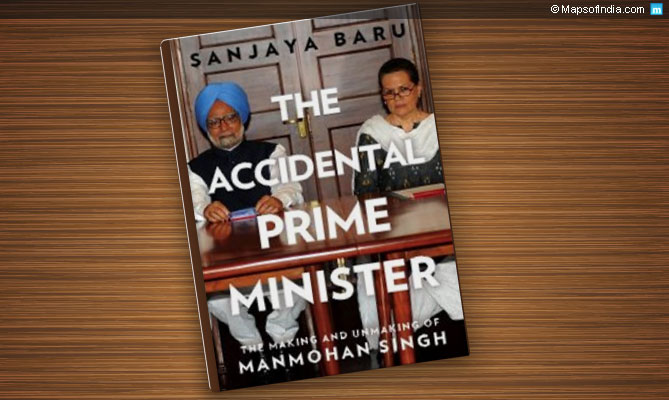The Accidental Prime Minister by Sanjaya Baru is an account of former Prime Minister Manmohan Singh’s two terms – UPA-1 and UPA-2. Sanjaya Baru, who was Singh’s media advisor, attempts to put his master in a positive light despite what went inside and in the media reports about Singh. The book primarily talks about the rise and fall or simply the building of ‘King’ Singh to a puppet-like Singh dancing to the tunes of the UPA chief. Though the book doesn’t cite straight references and names, there are enough hints for the political masters and the common man to judge the then Prime Minister’s efficiency and honesty.
Baru sees no mistake with Singh. According to the author, Singh’s first tenure from 2004 to 2009 was unreasonably successful and he terms it as ‘The Accidental Prime Minister’. In the second tenure, Baru resigned due to certain reasons which he doesn’t term as necessary to inform the readers. But he does give a hint when he mentions in the book, “It is better to leave when people start asking why instead of when.”
In his second tenure after 2009, Singh had a lot of difficulties and a puppet-like term was attached with his name by the media. Reaction of Singh to the corruptions and how he felt helpless to resign from the second tenure, unlike the first tenure when he threatened to resign and sealed the Indo-US nuclear deal is told by Baru in this book. In the first term he knew that no one capable was there but the second term had hints of Rahul Gandhi as the heir successor, which held Singh back from calling it quits.
Was silence the way to combat corruption?
As corruption tarnished the image of the United Progressive Alliance (UPA), Singh’s image dilapidated too. On account of the issues Baru raises in the book he undoubtedly tried to give a kinder image to Singh but also poses a question – Should Singh have resigned as corruption hit the party and not defend the Government? Singh did not want more troubles and he chose to be quiet and serve.
Shouldering all the Party ups and downs
Was silence the way to combat situations, being the Prime Minister? Singh could have left the position but he chose to shoulder all the ups and downs alongside the party, which in turn resulted in media calling him “Sin is King”, compared to the term “Singh is King” which he received in his first tenure. Leaving would have meant more allegations and party accusing him of deceiving them. Hence, he chose to be quiet yet in attendance until he seemed like a burden to them. The author of this book highlights how Singh himself chose a different path for himself when he could have decided to leave and kept the tag of being a successful Prime Minister of the UPA-1.
The Sonia Gandhi-Manmohan Singh joint venture had differences but still the relationship endured for a long time. Baru tries to answer whether or not it was a thriving partnership and why did the partnership flourish in spite of the complexities. But the reader is not able to get the exact answer to this question. There were differences especially in the second tenure of Singh when Rahul Gandhi came into the picture and Baru explains it to the readers that Singh as a Prime Minister was omitted from important decisions and his faithfulness remained unrewarded. Was it the reason for Singh’s failure in UPA-2?
Gandhi family – prime hinderance
The Accidental Prime Minister by Baru shows that it was the Gandhi family that resulted in a barrier between Singh’s prominence and his position as the Prime Minister but he also makes it clear that it was not the only reason. Singh’s inability, failing to possess a strong hold for himself at such a big position from the time when he started under PV Narasimha Rao in the 90s, proved fatal too. Singh’s apparent commitment to ensuring Rahul’s succession was even more misplaced. As Baru mentions, there are gaps in the book because of information that he could not publish or did not have access to. An uneven narrative of the Gandhi-Singh partnership is given in this book by Baru.
Politics within the Congress and attempts to weaken the Sonia-Singh partnership was evident but the book also attempts to enlighten how Sonia Gandhi refused any alteration in leadership and mentioned that Singh was the only leader they had in the second tenure. The Congress president constantly met Singh at his residence and tried to clarify things, but Singh hardly went to 10 Janpath except for attending committee meetings. As per media and other sources, Singh was burdened and came to be known as the UPA president’s puppet. The book poses a question on the reader’s mind: Whether it was Singh’s incapability and meekness or Sonia Gandhi’s interference in governing the country. The book to an extent lines reasons for Singh’s collapse in the second term but there are enough gaps to comprehend anything.
Full freedom in management of coalition
The reader clearly gets to know that the Prime Minister had full freedom in the management of the coalition without intrusion. Baru as a media adviser to Singh had suggested to keep the young leaders in the circle but acceptance to the idea isn’t mentioned in the book. As corruption hit UPA-2, readers look for answer as to why a relationship with ministers like A Raja was maintained as the 2G scam leaked out. The downfall had started gradually!
Though Baru has written this book in support of his master and shows him in a positive light, he does not forget to mention the drawbacks and shortcomings of Singh. Undoubtedly, Sonia Gandhi was the highest power even when Singh held the position for the only reason that he could not be a politician – one like Sonia Gandhi! He was mentioned by Narasimha Rao as a successful economist rather than a politician in one of his interviews.
According to Baru, Singh might have had two exceptionally contradictory terms: UPA 1 and UPA 2, but his inputs, contributions and attempt to keep the party intact will be historical. When Baru talks about Singh’s power as a mere power without any force in his ‘Responsibility without Power’, the reader is left wondering whether Singh was meek and submissive to take any action and why was it so. Well, according to Baru, Singh did what he could and felt right!
“You see, you must understand one thing. I have come to terms with this. There cannot be two centres of power,” Manmohan Singh had said.
Sanjaya Baru is currently director of Geo-Economics and Strategy at the International Institute of Strategic Studies. He is also a political commentator and analyst. Earlier he had been editor of Financial Express and Business Standard. He served as media advisor to Prime Minister Manmohan Singh from 2004 to 2008. The book had created a lot of controversy. However, Baru states that it was just an attempt to show Singh in a more compassionate light.





